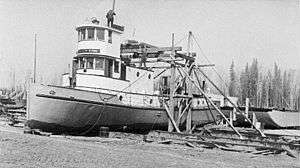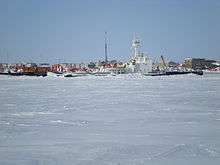Northern Transportation Company

Northern Transportation Company Limited (NTCL) was a marine transportation company operating primarily in the Mackenzie River watershed of the Northwest Territories and northern Alberta, and the Arctic Ocean using a fleet of diesel tug boats and shallow-draft barges. NTCL filed for bankruptcy in 2016 and its assets were acquired by the Government of the Northwest Territories later that year.
History
The company was an outgrowth of the competition in the Yukon between the new Northern Trading Company and the entrenched Hudson's Bay Company.[1] Colonel J.K. Cornwell, one of the principals of the Northern Trading Company,[1] ran his first steamer, The Midnight Sun, on the Lesser Slave Lake River in 1904.[2] The company acted as a kind of subsidiary of the Northern Trading Company until its formal creation in 1930 as Northern Waterways Limited, but its name was changed in 1934 to the Northern Transportation Company Limited. [3] In 1936, it was taken over by the Eldorado Gold Mines Limited and Arthur Berry was appointed manager in Edmonton. In 1944, it became a Crown corporation when its parent, then known as Eldorado Mining and Refining, was nationalized by the Government of Canada.[3]
NTCL's water freighting activities in the early years were focused on the Athabasca/Slave/Mackenzie River systems as a means to supply the Northwest Territories and northern Alberta with freight. Mineral development, commercial sawmills, wartime strategic projects (such as the Canol pipeline in 1942), and the growth of settlements in these districts lead to a growth in demand for NTCL's services. It's flagships were the Radium Queen and Radium King both commissioned in 1937 for use on the upper and lower Slave Rivers. [4] Other vessels in this fleet included the Radium Express, Radium Yellowknife, Radium Prince, Radium Cruiser, Radium Scout, Radium Charles, Radium Gilbert and Radium Lad, earning the fleet the name "The Radium Line". Port Radium on Great Bear Lake, a mine that supplied much of the uranium used by the Manhattan Project, and later the uranium mines on Lake Athabasca in northern Saskatchewan, were key destinations for the fleet. All of the tugs had extremely shallow draft, and mounted their propellers in cavities under their hull. Five vessels in the fleet, the George Askew, the Watson Lake, Horn River, Sandy Jane and Great Bear, did not include "Radium" in their name.[5]
Construction of Distant Early Warning communication sites along the Arctic Ocean coastline in the 1950s provided an opportunity for the company to expand and engineer larger and more efficient tugboats and barges. In 1975, then under the jurisdiction of the Coast Guard Northern Division of Transport Canada, it became the sole marine shipper in the Canadian Arctic operating of out of Churchill, Manitoba.[3] In 1959, it moved its operational headquarters from Fort Smith on the Slave River, to the town of Hay River.[6] In 1965 NTCL purchased Yellowknife Transportation Company and Arctic Transportation to become sole commercial marine freighter in the Northwest Territories and Arctic Ocean.

In 1985, NTCL was purchased by the Inuvialuit Development Corporation and Nunasi Corporation, two native-owned corporations.[7][3] On April, 1 2014 the Inuvialuit Development Corporation (IDC) bought the 50% share of NorTerra held by Nunasi. This purchase of NorTerra gave the IDC complete control of Canadian North, NTCL and other companies that were jointly held.[8][9] NTCL filed for bankruptcy in 2016 and its assets were acquired by the Government of the Northwest Territories later that year in order to ensure that the essential transportation service continued for residents of the Northwest Territories. [10]
References
- 1 2 Ray, Arthur J. (1990) The Canadian Fur Trade in the Industrial Age University of Toronto Press, Toronto, p. 104, ISBN 0-8020-6743-3
- ↑ MacGregor, James Grierson (1974) Paddle wheels to bucket-wheels on the Athabasca McClelland and Stewart, Toronto, p. 116, ISBN 0-7710-5450-5
- 1 2 3 4 McCalla, Robert J. (1994) Water Transportation in Canada Formac Publishing Company, Halifax, p. 207-210, ISBN 0-88780-247-8
- ↑ The Montreal Gazette, April 15, 1937
- ↑
"Status Report for the Historic Northern Transportation Route redacted colour" (PDF). Atomic Energy of Canada. December 2005. p. 86. Retrieved 2018-01-13.
Ships were used along the NTR to move barges loaded with uranium ore and concentrates (among other materials and supplies). Some vessels also transported cargo on board. Fifteen Radium Series vessels used along the NTR were identified in SENES (1994). Three were ddetermined to have been scrapped, and the disposition of one, the Radium Cruiser, was unknown. Radiological investigations were conducted on the other eleven vessels. Only one, the Radium Gilbert, showed any evidence of contamination.
- ↑ "History - the Town of Hay River" Archived 2008-05-13 at the Wayback Machine., official website of the Town of Hay River
- ↑ The NorTerra Group of Companies Archived 2008-12-04 at the Wayback Machine., corporate website
- ↑ Nunasi Corp. sells its stake in NorTerra, Canadian North
- ↑ Nunasi Corp. sells its half of Norterra to the Inuvialuit
- ↑
See also
External links

- homepage of Northern Transportation Company Limited
- "Northern Transportation Company Limited" from Inuit Business Directory
- 1934 Northern Transportation Company Limited NWT Historical Timeline, Prince of Wales Northern Heritage Centre